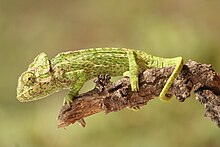Chamaeleontiformes is a hypothesized clade (evolutionary grouping) of iguanian lizards defined as all taxa sharing a more recent common ancestor with Chamaeleo chamaeleon (the common chamaeleon) than with Hoplocercus spinosus (the Brazilian spiny-tailed lizard), Polychrus marmoratus (bush lizard), or Iguana iguana (green iguana). It was named by paleontologist Jack Conrad in 2008 to describe a clade recovered in his phylogenetic analysis that included the extinct genus Isodontosaurus, the extinct family Priscagamidae, and the living clade Acrodonta, which includes agamids and chameleons.[1] It is a stem-based taxon and one of two major clades within Iguania, the other being Pleurodonta. Below is a cladogram from Daza et al. (2012) showing this phylogeny:[2]
| Chamaeleontiformes Temporal range: Early Jurassic- present,
| |
|---|---|

| |
| Common chameleon, Chamaeleo chamaeleon | |
| Scientific classification | |
| Domain: | Eukaryota |
| Kingdom: | Animalia |
| Phylum: | Chordata |
| Class: | Reptilia |
| Order: | Squamata |
| Suborder: | Iguania |
| Clade: | Chamaeleontiformes Conrad, 2008 |
| Subgroups | |
| Iguanomorpha |
| ||||||||||||||||||
Other analyses place Priscagamidae outside Iguania altogether, resulting in a Chamaeleontiformes that only includes Isodontosaurus and Acrodonta. Below is a cladogram from Conrad (2015) with this phylogeny:[3]
| Iguanomorpha |
| ||||||||||||||||||
References
edit- ^ Conrad, J. L. (2008). "Phylogeny and Systematics of Squamata (Reptilia) Based on Morphology". Bulletin of the American Museum of Natural History. 310: 1–182. doi:10.1206/310.1. hdl:2246/5915. S2CID 85271610.
- ^ Daza, J. D.; Abdala, V.; Arias, J. S.; García-López, D.; Ortiz, P. (2012). "Cladistic Analysis of Iguania and a Fossil Lizard from the Late Pliocene of Northwestern Argentina". Journal of Herpetology. 46: 104–119. doi:10.1670/10-112. hdl:11336/61054. S2CID 85405843.
- ^ Conrad, Jack L. (2015). "A New Eocene Casquehead Lizard (Reptilia, Corytophanidae) from North America". PLOS ONE. 10 (7): e0127900. Bibcode:2015PLoSO..1027900C. doi:10.1371/journal.pone.0127900. PMC 4489568. PMID 26131767.